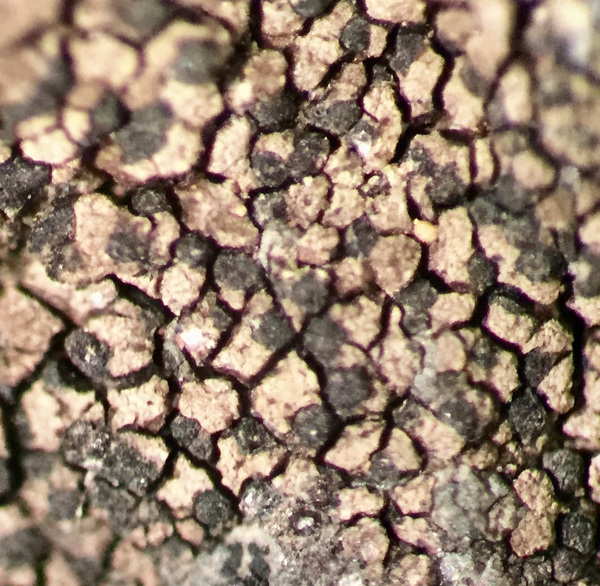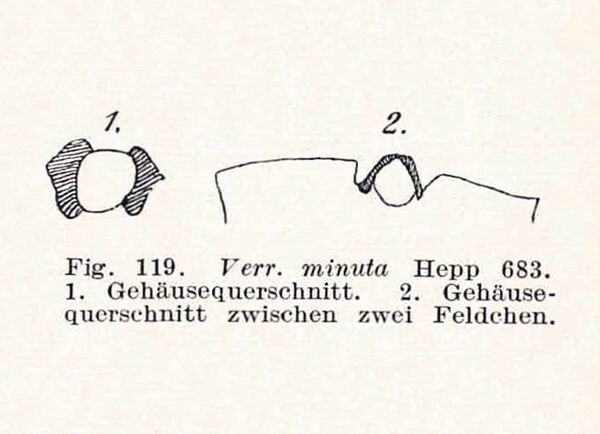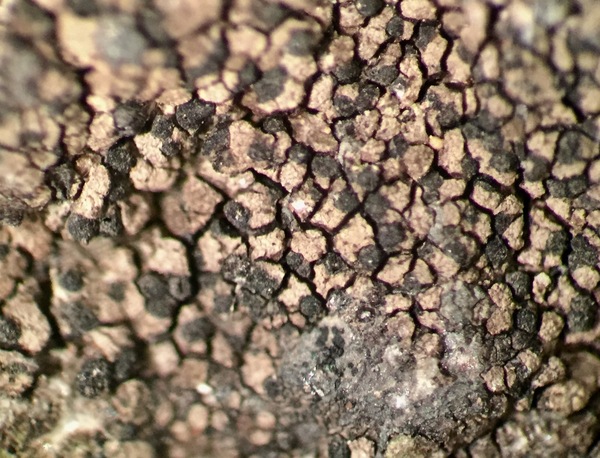Verruculopsis minuta (Hepp) Krzew.
Polish Bot. Stud., 27: 115, 2012. Basionym: Verrucaria lecideoides var. minuta Hepp - Flecht. Eur.: nr. 683, 1860.
Synonyms: Verrucaria minuta (Hepp) Zschacke
Description: Thallus crustose, episubstratic, 0.1-0.2(-0.3) mm thick, minutely areolate, whitish to pale brown. Areoles 0.2-0.3(-0.5) x 0.1–0.3 mm, tetragonal to nearly rounded, separated by large (0.1-0.15 μm) cracks, the margins concolorous with upper surface or paler. Cortex (pseudocortex) weakly differentiated, 20-30 μm thick, colourless to pale brown, overlain by an epinecral layer; algal layer 80-100 μm thick; medulla white, 100-150 μm thick, with crystals visible under polarized light, I-, without a black basal layer. Perithecia globose or conical, 0.2-0.3 mm across, mainly marginal or arising between the areoles, the apical part sometimes slightly flattened. Involucrellum hardly distinguishable from exciple, completely surrounding it; exciple 0.15-0.2 mm across, the wall paraplectenchymatous, thick, dark brown to black, pale brown only at base; hamathecium of periphyses along the ostiolar channel, short pseudoparaphyses in upper part of the perithecium, and paraphyses tending to disappear early, the periphyses 10-15 x 1-1.5 μm; hymenial gel hemiamyloid, I+ red (I+ blue at very low concentrations of I), K/I+ blue. Asci 8-spored, clavate, fissitunicate and bitunicate, the wall not amyloid, not or only slightly thickened above, Verrucaria-type. Ascospores 1-celled, hyaline, ellipsoid, 11-15(-18) x 5-7(-8) μm. Photobiont chlorococcoid. Spot tests: K-, C-, KC-, P-, UV-. Chemistry: without lichen substances.
Growth form: Crustose
Substrata: rocks
Photobiont: green algae other than Trentepohlia
Reproductive strategy: mainly sexual
Poorly known taxon in need of further study
Commonnes-rarity: (info)
Alpine belt: absent
Subalpine belt: absent
Montane belt: very rare
Dry submediterranean belt: rare
Humid submediterranean belt: rather rare
Padanian area: absent
pH of the substrata:
1 2 3 4 5
Solar irradiation:
1 2 3 4 5
Aridity:
1 2 3 4 5
Eutrophication:
1 2 3 4 5
Poleotolerance:
0 1 2 3
Altitudinal distribution:
1 2 3 4 5 6
Rarity
absent
extremely rare
very rare
rare
rather rare
rather common
common
very common
extremely common
Loading data...
Occurrence data
Predictive map
Growth form: Crustose
Substrata: rocks
Photobiont: green algae other than Trentepohlia
Reproductive strategy: mainly sexual
Poorly known taxon in need of further study
Commonnes-rarity: (info)
Alpine belt: absent
Subalpine belt: absent
Montane belt: very rare
Dry submediterranean belt: rare
Humid submediterranean belt: rather rare
Padanian area: absent
pH of the substrata:
| 1 | 2 | 3 | 4 | 5 |
Solar irradiation:
| 1 | 2 | 3 | 4 | 5 |
Aridity:
| 1 | 2 | 3 | 4 | 5 |
Eutrophication:
| 1 | 2 | 3 | 4 | 5 |
Poleotolerance:
| 0 | 1 | 2 | 3 |
Altitudinal distribution:
| 1 | 2 | 3 | 4 | 5 | 6 |
Rarity
absent
extremely rare
very rare
rare
rather rare
rather common
common
very common
extremely common
Loading data...
Occurrence data
Predictive map










